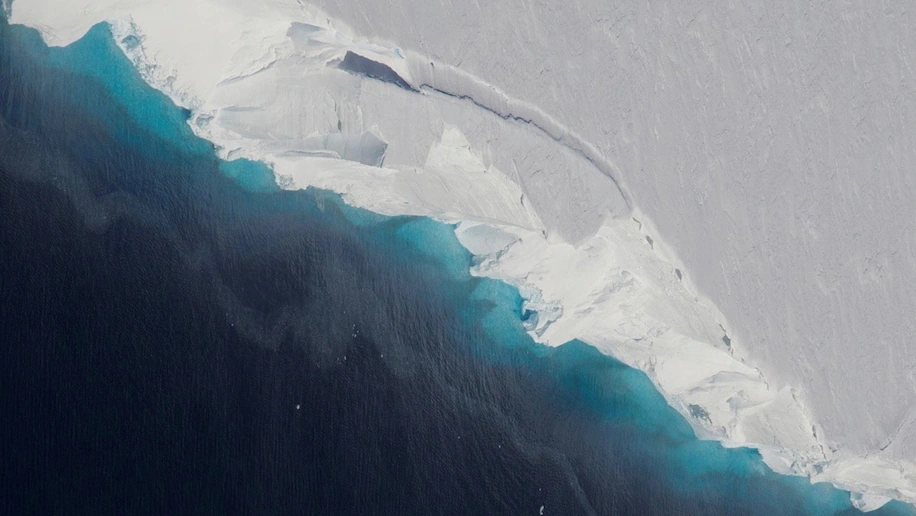After the abject failure of COP26, two startling reports have come out of the most recent earth sciences summit. First, the Arctic is actually warming FOUR times as fast, and secondly, one of the biggest glaciers in Antarctica is likely to shatter very soon.
Fuzzy good feelings below from CNBC on the latter:
An ice shelf holding a critical glacier in Antarctica could shatter within the next five years, scientists warned on Monday during an American Geophysical Union meeting.
The Thwaites Glacier is a Florida-sized sheet that’s already responsible for about 4% of global annual sea level rise as it slowly melts into the ocean. But the glacier sits on an ice shelf vulnerable to failing due to newly detected fissures on its surface and a major fracture across the entire shelf, according to satellite images.
The cracks in the Antarctic ice shelf are similar to those in a car windshield, where a slowly growing crack reveals that the windshield is weak and a slight bump to the vehicle could prompt the windshield to immediately break apart into hundreds of pieces of glass, according to Oregon State University glaciologist Erin Pettit.
During the meeting, the scientists said they’ve targeted the weak and strong parts of the shelf and concluded that fractures will take a “zig-zag” pathway through the ice and ultimately cause the shelf to break in as little as five years.
Global sea levels will rise two to six feet by 2100 on the current trajectory, driven mainly by melting in Greenland and Antarctica, according to NASA satellite data. However, scientists have warned that projections underestimate the impact of climate change on sea level rise.
“We are already on track for sea level rise in the next several decades that will impact coastal communities worldwide,” Pettit said. “We can’t reverse this sea level rise, so we need to consider how to mitigate it and protect our coastal communities now.”
While at the top of the world, researchers say the Arctic is warming way faster than first thought. From Science:
The Arctic is warming twice as fast as the rest of the world. But that figure, found in scientific studies, advocacy reports, the popular press, and even the 2021 U.N. climate assessment, is incorrect, obscuring the true toll of global warming on the north, a team of climate scientists reports this week. In fact, the researchers say, the Arctic is warming four times faster than the global average.
“Everybody knows [the Arctic] is a canary when it comes to climate change,” says Peter Jacobs, a climate scientist at NASA’s Goddard Space Flight Center, who presented the work on 13 December at a meeting of the American Geophysical Union. “Yet we’re misreporting it by a factor of two. Which is just bananas.”
The researchers found Arctic warming has been underestimated for a couple of reasons. One is climate scientists’ tendency to chop each hemisphere into thirds and label the area above 60°N as the “Arctic”—an area that would include, for example, most of Scandinavia. But the true definition of the Arctic is defined by Earth’s tilt. And, as has been known for centuries, the Arctic Circle is a line starting at 66.6°N. When researchers lump in the lower latitudes, “you’re diluting the amount of Arctic warming you’re getting,” Jacobs says. “That is not a trivial thing.”
The other difference is the choice of time periods over which the warming rate is calculated. Jacobs and his colleagues focused on the past 30 years, when a linear warming trend emerged for the Arctic. Analyses that look at longer term trends see less divergence between the Arctic and the world. That’s because before 1990, the Arctic’s temperatures fluctuated, and even cooled for decades because of air pollution, including light-blocking sulfate aerosols that swept in from the northern midlatitudes, says Mark England, a climate scientist at the University of California, Santa Cruz, who is unaffiliated with the new work. As the world moves off fossil fuels and curbs pollution, he says, “this scenario is not going to repeat itself again.”
Luckily we have “leaders” in government who only understand linear consequences and not multi variate problems like climate change, and still want to dig fossil fuels out of the ground even when the evidence is so clear, you could drink it. And there will be plenty of that to drink in the years to come, as sea levels rise and wipe out most of our Pacific neighbours.
For a bit of perspective, check out Jonathan Pie at COP26:
